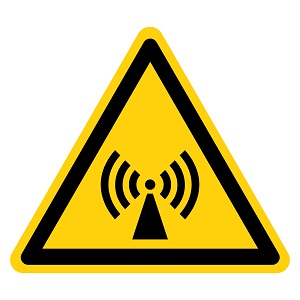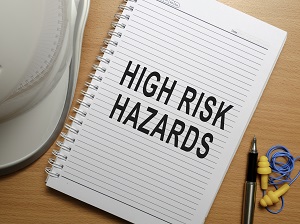RF radiation is a type of non-ionizing radiation. Other types of non-ionizing radiation include:
- Extremely Low Frequency Radiation (ELF) >> high voltage power lines
- Microwave Radiation (MW) >> radio emitters and cell phones
- Infrared Radiation (IR) >> furnaces, heat lamps and IR lasers
- Ultraviolet Radiation (UV) >> sunlight, black lights, welding arcs
Radiofrequency (RF) radiation refers to energy that transmits wireless information with frequencies between 3 kilohertz (kHz) to 300 gigahertz (GHz). RF energy is essential for telecommunications services such as radio and television broadcasts, cellular telephones, microwave point-to-point links, and satellite communications.
RF energy is released by the movement of electrical charges in transmitting antennas. Transmitting antennas come in different shapes and sizes and emit RF radiation in different directions, up to 360 degrees.
Low-level RF radiation it is not considered hazardous, but high levels of RF radiation generate heat in water-rich substances, like the human body. High RF radiation exposure levels can produce symptoms called “thermal effects” like reddening of the skin or even burns.

Workers may be exposed to RF radiation if they work near RF-generating antennas. RF radiation exposure is most likely to happen near antennas used for cellular and other personal communications services because they are often located on rooftops, the sides of buildings, and other elevated structures. Some antennas are designed to blend into their surroundings and workers may not be aware of them. Not all antennas transmit RF energy, some of them may only be receivers.
OSHA Construction Standard 1926.54(l) Employees shall not be exposed to microwave power densities in excess of 10 milliwatts per square centimeter. [OSHA note: This standard pertains to construction work, including the painting of towers.]
The RF energy that could be radiated by cellular and other personal communications services antennas depends on the number of transmitters, the power of each transmitter, and the type of antenna. Generally, the highest exposure levels are at the same height and directly in front of the antenna, but the exposure levels rapidly decrease with distance.

Distance is important when it comes to reducing workers’ RF radiation exposure. The power density decreases the farther away a worker is from the source.
OSHA General Industry Standard 1910.97(a)(2)(i) For normal environmental conditions and for incident electromagnetic energy of frequencies from 10 MHz to 100 GHz, the radiation protection guide is 10 milliwatts per square centimeter as averaged over any possible 0.1-hour period.
It is always best to exercise caution when working near antennas. Follow all instructions on posted signs. Know how to recognize and understand the information presented on RF hazard warning signs. Do not cross fences or barriers that are set up to restrict access.
Assume that all antennas are active and operating at full power. Pre-plan work tasks and travel routes to limit time spent walking through and working in RF exposure areas (RF fields). Limit the time spent performing tasks near antennas. Do not touch any energized antennas. Touching an active antenna may result in a burn.
Stay at least six feet away from a single antenna facing the direction of the work and at least 10 feet away from two or more antennas facing the direction of the work. Note: Cylindrical or rod-shaped antennas may emit RF radiation in all directions.

A personal RF monitor can warn you if you are in an area where RF radiation is at a dangerous level, based on the FCC’s exposure guidelines. RF monitors can alert workers to potential RF radiation exposure by sounding an alarm, flashing lights, or vibrating. Workers must be trained on how to use RF monitors and understand how to interpret RF exposure levels.
The FCC’s exposure guidelines depend upon the electric and magnetic field strength and power density of the transmitter, so the only way to accurately measure a worker’s exposure to RF radiation is with a personal RF monitor.
If an RF monitor is not available, these tips can help:
- Look for warning signs posted near RF antennas that should identify the hazard and indicate where to get more information.
- Avoid standing directly in front of or close to an antenna. As a rule of thumb, stay six feet away from a single antenna and 10 feet away from a group of antennas.
- If you are not sure, ask the building owner, or the property manager if RF-generating antennas are present in the work area. They should have the information, or know whom to contact for information about antennas, their locations, and the RF radiation levels.

If workers are not able to maintain a safe distance while working, the antenna owner (or contact provided on the warning sign) should be notified. A request should be made to have the site powered down temporarily unless they can provide a written confirmation that it is safe to perform work. Reducing power or switching to an auxiliary transmitter (if available) are also options to reduce exposures.
All antenna owners (licensees) are responsible for compliance with FCC guidelines including preventing the public and workers from exposure to harmful RF levels.
RF protective clothing along with an RF monitor should only be used if there is no alternative and work is required in an area that exceeds the FCC’s maximum permissible exposure limit. If RF protective clothing is required, a full RF protective suit should be used which includes an integrated hood, overshoes, socks and gloves.
RF protective clothing will only work if it is worn properly, and the RF monitor should be worn on the outside of the protective suit. Ensure workers have been provided education and training on how to wear required PPE and the specific RF devices to be used.

.jpg)

